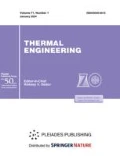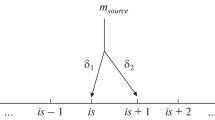Abstract—
The article presents the results from numerical modeling of aerosol particles' deposition process during their transportation in the horizontal section of the reactor plant’s primary circuit model for the conditions typical for a severe accident at an NPP equipped with VVER reactors. The effect that the bulk condensation of cesium vapors has on the growth and deposition of aerosols during their transportation is analyzed. The influence of the initial size and concentration of aerosol particles on their growth rate and subsequent deposition is considered. Homogeneous condensation occurring in the absence of heterogeneous condensation nuclei (solid aerosol particles) and also heterogeneous condensation under the conditions in which nuclei of the new phase do not emerge according to the homogeneous mechanism are considered as the limit cases. Data on the average size of the produced droplets and aerosol particles along the channel axis in the condensation zone with the varied value of aerosol particles mass fraction in the flow have been obtained, which corresponded to different ratios of the condensate mass fraction in the form of droplets and liquid layer on the surface of solid aerosol particles. It has been established that the general deposition rate decreases if the flow contains droplets generated as a result of homogeneous bulk condensation and having a size smaller than the size of grown aerosol particles. The article describes the analysis scheme of the modeled section whose geometrical shape was specified based on the horizontal section of the experimental installation in the FALCON-ISP1 series of experiments on the deposition and transport of radionuclide aerosols. The cesium vapor homogeneous-heterogeneous condensation process is modeled by numerically solving—using the method of moments—the kinetic equation for the droplet size distribution function with involvement of the authors’ COND-KINET-1 computer program. The transport and deposition of aerosol particles in the primary circuit channel were modeled using the MAVR-TA computer code developed at the National Research Center Kurchatov Institute.


Similar content being viewed by others
REFERENCES
P. C. Reist, Introduction to Aerosol Science (Macmillan, New York, 1984; Mir, Moscow, 1987).
N. M. Kortsenshteyn and L. V. Petrov, “The effect of dustiness of combustion products and coagulation processes on the parameters of submicron particles resulting from coal burning,” Colloid J. 81, 245–252 (2019).
N. M. Kortsenshtein and L. V. Petrov, “Numerically simulating the parameters of submicron particles generated in coals burning,” Therm. Eng. 65, 435–442 (2018). https://doi.org/10.1134/S0040601518070030
L. N. Kmetyk, MELCOR 1.8.1 Assessment: Marviken-V Aerosol Transport Tests ATT-2b/ATT-4, SAND92-2243 (Sandia National Laboratories, Albuquerque, 1993).
N. B. Siccama, MELCOR 1.8.1 Assessment: FALCON ISP-34, ECN-R94-009 (ECN Nuclear Energy Process Analysis Section, 1994).
T. Haste, F. Payot, and P. D. W. Bottomley, “Transport and deposition in the Phebus FP circuit,” Ann. Nucl. Energy 61, 102–121 (2013). https://doi.org/10.1016/j.anucene.2012.10.032
N. Girault and F. Payot, “Insights into iodine behavior and speciation in the Phebus primary circuit,” Ann. Nucl. Energy 61, 143–156 (2013). https://doi.org/10.1016/j.anucene.2013.03.038
A. M. Beard and E. Kauppinen, Data Report: Characterization of FALCON Aerosol Source, FAL/ISP(92)22 (AEA Reactor Services, 1992).
N. M. Kortsenshteyn and A. K. Yastrebov, “Bulk condensation in a dusty vapor–gas flow with regard to dust particle size distribution,” Colloid J. 78, 472–477 (2016).
L. E. Sternin, Fundamentals of Gasdynamics of Two-Phase Nozzles Flows (Mashinostroenie, Moscow, 1974) [in Russian].
N. A. Fuchs, Evaporation and Droplet Growth in Gaseous Media (Akad. Nauk SSSR, Moscow, 1958; Pergamon, London, 1959).
A. A. Amosov, Yu. A. Dubinskii, and N. V. Kopchenova, Computational Methods for Engineers: Study Aid (Vysshaya Shkola, Moscow, 1994) [in Russian].
J. R. Brock, “On the theory of thermal forces acting on aerosol particles,” J. Colloid Interface Sci. 17, 768–780 (1962). https://doi.org/10.1016/0095-8522(62)90051-X
Yu. B. Shmel’kov, Yu. A. Zvonarev, L. V. Petrov, and N. V. Shutov, “Development and verification of the MAVR-TA code for modeling the output of fission products and their transfer under a protective shell in a severe accident at nuclear power plants with VVER,” Vopr. At. Nauki Tekh., Ser.: Fiz. Yad. Reakt., No. 5, 92–104 (2018).
Author information
Authors and Affiliations
Corresponding author
Additional information
Translated by V. Filatov
Rights and permissions
About this article
Cite this article
Petrov, L.V., Shmelkov, Y.B. & Kortsenshteyn, N.M. The Impact of Cesium Vapor Bulk Condensation on the Transport of Aerosols in the Reactor Plant’s Primary Circuit during a Severe Accident at a Nuclear Power Plant with VVER. Therm. Eng. 67, 634–639 (2020). https://doi.org/10.1134/S0040601520090062
Received:
Revised:
Accepted:
Published:
Issue Date:
DOI: https://doi.org/10.1134/S0040601520090062




